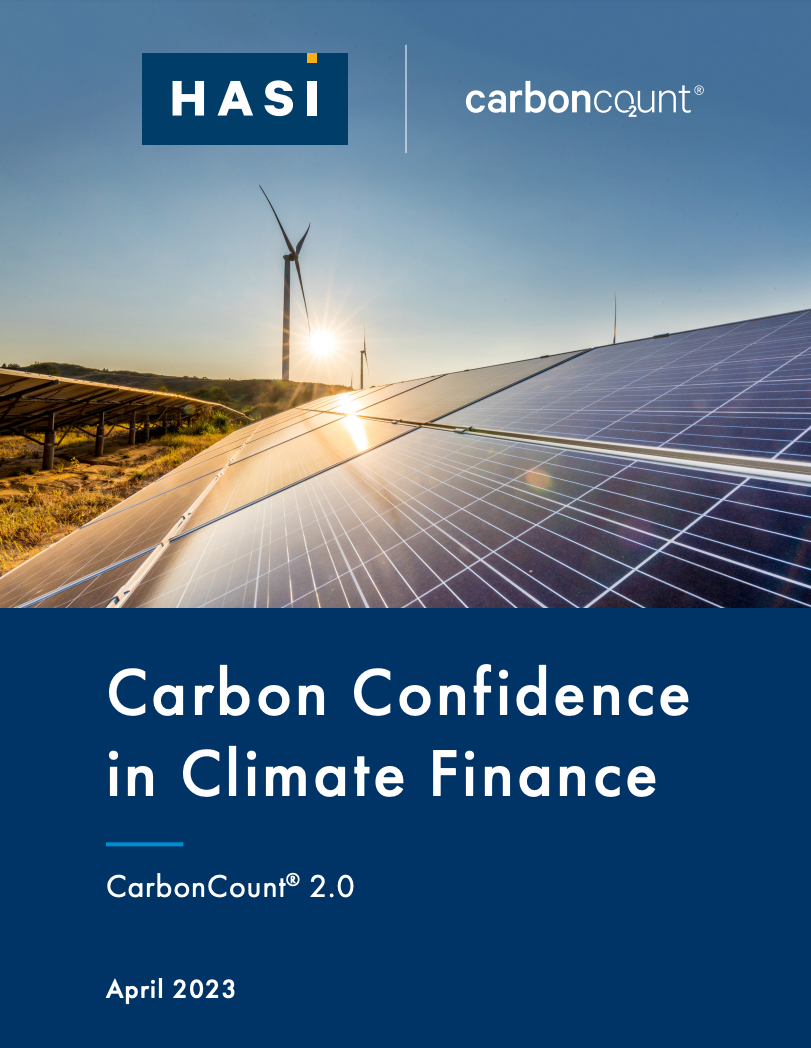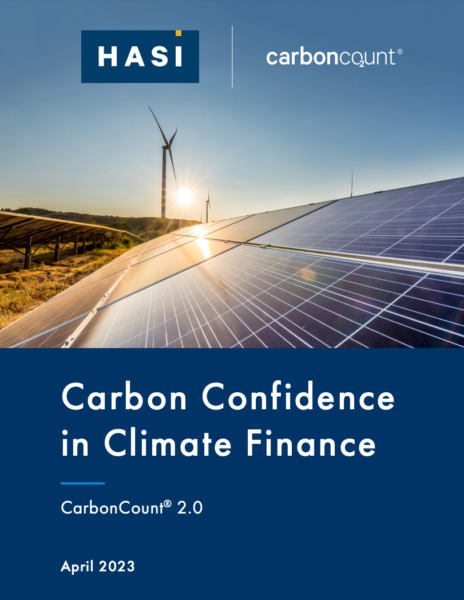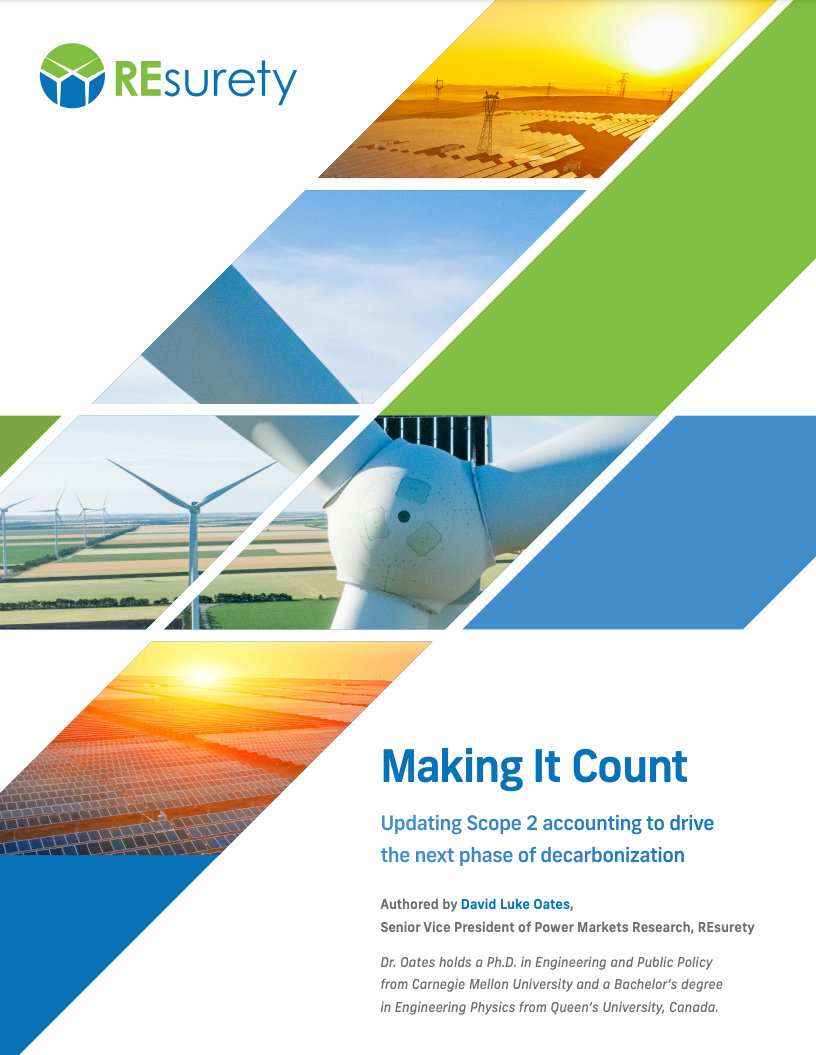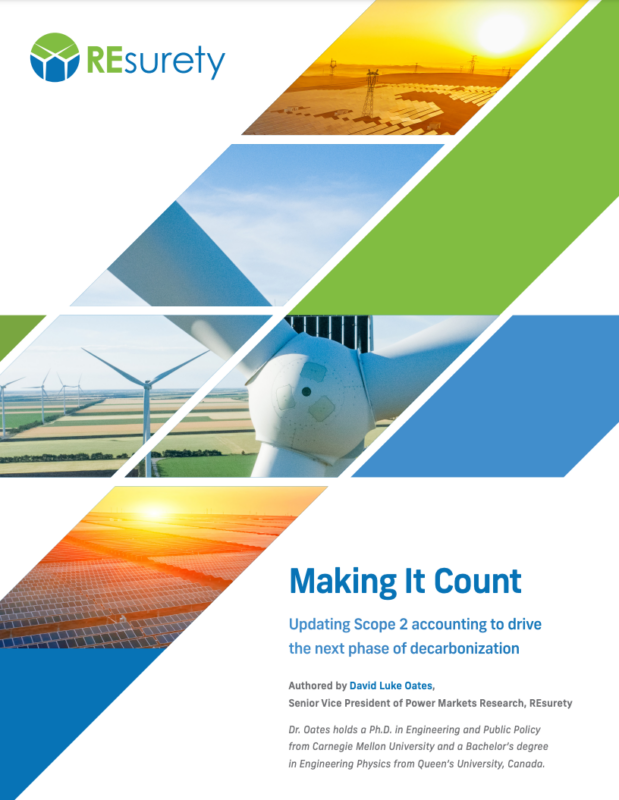
Authored by Lee Taylor, Co-Founder and CEO, REsurety
Clean energy leaders today agree clearly on one thing: annual MWh-based accounting was a phenomenally successful driver of our industry’s past success, but it is insufficient to meet the needs of our industry’s future – and our planet’s future.1 However, those same clean energy leaders have different proposals for what should replace annual MWh-based accounting. From these proposals two approaches have emerged: Hourly Energy Matching (the methodology advocated for by 24/7 proponents) and Carbon Matching (the methodology advocated for by the Emissions First Partnership).
Hourly Energy Matching asserts that buyers of clean energy should match their consumption with clean energy generation in both time and location. Carbon Matching advocates that buyers of clean energy calculate the induced carbon emissions of their consumption and then subtract the avoided carbon emissions of their clean energy procurement, with the goal of pursuing strategies for both consumption and generation, independently, to get to an end result of zero as fast as possible. In the corporate community, Google has led the charge on Hourly Energy Matching whereas the Emissions First Partnership (including Akamai, Amazon, General Motors, HASI, Heineken, Intel, Meta, Rivian, Salesforce, and Workday) has advocated for Carbon Matching.2
There is a perception by some that these two camps are in direct conflict. In reality, Carbon Matching and Hourly Energy Matching share a common long-term goal: a carbon-free grid. However, Carbon Matching and Hourly Energy Matching are two different strategies to achieve that goal and should be considered alternative – not mutually exclusive – options, each of which is an improvement over the status quo.
Hourly Energy Matching is an attempt to approximate the physical sourcing of clean energy. Said another way, Hourly Energy Matching is effectively a proxy for behind-the-meter co-location and temporal matching of clean energy generation and energy consumption. It is an effort to get most of the benefits of co-location without giving up the benefits of grid interconnection. Done correctly (more on this below), this strategy provides a tool to attempt to physically consume carbon-free energy.3
By contrast, Carbon Matching is an attempt to minimize carbon emissions as fast as possible. The basic premise is: our climate doesn’t care when and where carbon is emitted, it all goes into the same atmosphere and drives climate change. So Carbon Matching focuses on driving dollars to the projects and strategies that decrease overall carbon emissions as fast as possible, whether or not that results in consumption and clean energy generation occurring in the same time and location. For example: siting new load in a clean grid while siting new renewable generation in a dirty grid achieves faster decarbonization than co-locating load and generation in either one location.
Regarding the “done correctly” point above, I do have one significant bone to pick with the messaging to date by the Hourly Energy Matching camp. In many real world applications, Hourly Energy Matching has a significant “deliverability problem” that has thus far been downplayed or outright ignored. Here’s the problem: using grid connected projects as a “proxy” for co-location is only defensible if there are no material transmission constraints between the location of your generation and the location of your consumption. Just as transmission constraints drive dramatic price differences within a region, they also drive large differences in the carbon intensity of electricity within the same grid at the same time.
Hourly Energy Matching advocates acknowledge this and so define “deliverability” as existing between any two locations on the grid between which there is no material congestion. But, as a result of the complex and rapidly changing congestion patterns of modern grids, that means that whether or not generation in one location is “deliverable” to load in another changes every 5 minutes in many markets and can cause locations that are just a few miles apart to become non-deliverable. That reality presents challenges to the ease of Hourly Energy Matching’s implementation, so advocates have thus far taken a “let’s not let the perfect be the enemy of the good” approach and suggest using unjustifiably large geographic boundaries such as balancing authorities or the DOE’s geographic regions as approximations of deliverability.
But calling something deliverable doesn’t make it so. For example, in renewables-rich Texas, out of the hundreds of operating wind farms only two would be considered deliverable to Houston if you used energy price differentials as an indicator of congestion – as many have proposed.4 And congestion is not just a Texas problem. In MISO in 2022, renewables were being curtailed 71% of the time as a result of local congestion.5 In summary: matching generation and consumption hourly while ignoring local transmission constraints is the definition of precision without accuracy – and Hourly Energy Matching advocates need to acknowledge this and ensure that the implementation of “deliverability” consistently avoids that outcome.6
In the end, as a buyer of power, you have a choice. Is your goal to attempt to physically consume local carbon free energy? And are you comfortable knowing that your dollars spent could very likely have abated carbon further and faster if deployed elsewhere? If so, then you should pursue an Hourly Energy Matching strategy.
Alternatively, is your goal to reduce overall carbon emissions as fast as possible? And are you comfortable with the fact that your choice may lead you to invest in projects that aren’t located in your backyard? If so, then you should pursue a Carbon Matching strategy.
Both strategies have their respective merits and it is important to note that they are not mutually exclusive. I can speak to this personally. I live in Massachusetts, which means I live in a house that gets (relatively) little sunshine and draws power from a (relatively) clean grid. Even so, I installed solar panels on my roof in order to source carbon-free energy for my own consumption. However, like many 24/7 strategies, my rooftop solar system is both expensive and exclusive. The implied cost of carbon underlying the RECs generated by my rooftop system translates to nearly $650 per metric ton of avoided carbon. And, residential solar isn’t a financial option for all homeowners and is no option at all for renters. While I still feel good about my decision to install solar, I recognize that this kind of behavior alone simply is not cost-effective nor scalable enough to stave off the worst effects of climate change. Given that, the majority of my time and effort go into our work at REsurety, where we provide the tools required to enable Carbon Matching throughout the clean energy ecosystem (from corporate procurement, to energy storage, to hydrogen development) – with the primary objectives of maximizing the speed with which we decarbonize the grid as a whole.
Have a question on this topic? We’re always happy to discuss so send us a note at [email protected].
1 For further reading or listening on this, see: Carbon Accounting Changes Could Lift Corporate Greenhouse-Gas Emissions, WSJ, May 2023. GHG accounting reform could change energy investment, The Interchange Podcast, July 2023. Going beyond megawatt hour matching, Climate Positive Podcast, July 2023.
2 The Emissions First Partnership states that it supports companies with hourly match goals, and its carbon matching approach can serve as a foundation for those goals (see EFP website).
3 I say “attempt” instead of “ensure” on purpose, because it’s not possible to trace electrons from generation to consumption across a grid. 24/7’s advocates agree with this: “We know from Kirchoff’s circuit laws that electricity generated in one spot cannot be directed to a specific user over the electricity grid. Once you put electricity on the grid there is no actual way to know ‘the energy from wind farm X is going to my data center Y.’” – Google’s Green PPAs
4 Many Hourly Energy Matching proponents have suggested that two locations could be considered “deliverable” if the Locational Marginal Price (“LMP”) at the generator location is within 10% of the (hourly-matched) LMP at the consumption location. Using trailing 2-year observed prices, only 2 wind farms in Texas have experienced LMP differentials of less than 10% to Houston Hub.
5 See Table 1 from MISO’s 2022 State of the Market report. Wind and solar were on the margin and as such set pricing in 68% and 3% of intervals, respectively.
6 For more detail on how local transmission can undermine or even reverse the carbon benefits of hourly matching, see REsurety’s white paper on this topic related to defining green hydrogen: Emissions Implications for Clean Hydrogen Accounting Methods.








